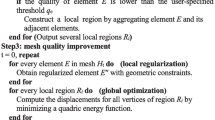Abstract
This paper presented a grid-based hexahedral element mesh generation algorithm for solid models with concave curved boundary lines. A deep study was focused on the boundary matching and quality improvement techniques. Firstly, a method for computing the curvature values of the triangle facets and sub-surfaces was proposed. In order to improve the surface mesh quality, a layer of new elements was inserted on the surface of the jagged core mesh. Then, a relative position relationship method was used to match C-edges of the solid model. Eight different types of free quadrilateral facet configurations were established. In order to handle the concave curve-matching problem, this paper proposed a method to modify the matching properties of the degenerate quadrilateral facets fitted on the same concave curved boundary line by unifying their orientations to point to the same sub-surface. In addition, six mixed templates were newly proposed to improve the geometrical topology of the degenerate elements associated with concave curves and sharp features. The positions of the nodes were smoothed by the modified Laplacian method and objective function. Finally, the effectiveness and reliability of the algorithms proposed in this paper were demonstrated by a practical example.














Similar content being viewed by others
References
Benzley SE, Perry E, Merkley K, Clark B, Sjaadama G (1995) A comparison of all hexagonal and all tetrahedral finite element meshes for elastic and elasto-plastic analysis. In: Proceedings of the 4th international meshing roundtable, Albuquerque, NM, pp 179–191
Owen SJ (1998) A survey of unstructured mesh generation technology. In: Proceedings of the 7th international meshing roundtable, Dearborn, MI, pp 239–267
Azarenok BN (2007) A method of constructing adaptive hexahedral moving grids. J Comput Phys 226(1):1102–1121
Li TS, Mckeag RM, Armstrong CG (1995) Hexahedral meshing using midpoint subdivision and integer programming. Comput Methods Appl Mech Eng 124(1–2):171–193
Price MA, Armstrong CG, Sabin MA (1995) Hexahedral mesh generation by medial surface subdivision: part I: solids with convex edges. Int J Numer Methods Eng 38(19):3335–3359
Staten ML, Kerr RA, Owen SJ, Blacker TD, Stupazzini M, Shimada K (2010) Unconstrained plastering—hexahedral mesh generation via advancing-front geometry decomposition. Int J Numer Methods Eng 81(2):135–171
Schneiders R (1996) A grid-based algorithm for the generation of hexahedral element meshes. Eng Comput 12(3–4):168–177
Ito Y, Shih AM, Soni BK (2009) Octree-based reasonable-quality hexahedral mesh generation using a new set of refinement templates. Int J Numer Methods Eng 77(13):1809–1833
Zhang Y, Hughes TJR, Bajaj CL (2010) An automatic 3D mesh generation method for domains with multiple materials. Comput Methods Appl Mech Eng 199(5–8):405–415
Zhang HM, Zhao GQ, Ma XW (2007) Adaptive generation of hexahedral element mesh using an improved grid-based method. Comput Aided Des 39(10):914–928
Su Y, Lee KH, Kumar AS (2004) Automatic hexahedral mesh generation for multi-domain composite models using a hybrid projective grid-based method. Comput Aided Des 36(3):203–215
Qian J, Zhang Y (2010) Sharp feature preservation in octree-based hexahedral mesh generation for CAD assembly models. In: Proceedings of 19th international meshing roundtable, Chattanooga, TN, pp 243–262
Marechal L (2009) Advances in octree-based all-hexahedral mesh generation: handling sharp features. In: Proceedings of 18th international meshing roundtable, Salt Lake City, UT, pp 65–84
Owen SJ, Shepherd JF (2009) Embedding features in a Cartesian grid. In: Proceedings of 18th international meshing roundtable, Salt Lake City, UT, pp 117–138
Kwak DY, Im YT (2003) Hexahedral mesh generation for remeshing in three-dimensional metal forming analysis. J Mater Process Technol 138(1–3):531–537
Schneiders R (1995) Automatic generation of hexahedral finite element meshes. In: Proceedings of the 4th international meshing roundtable, Albuquerque, NM, pp 103–114
Knupp PM (2003) A method for hexahedral mesh shape optimization. Int J Numer Methods Eng 58(2):319–332
Knupp PM (2000) Achieving finite element mesh quality via optimization of the Jacobian matrix norm and associated quantities. Part II-A framework for volume mesh optimization and the condition number of the Jacobian matrix. Int J Numer Methods Eng 48(8):1165–1185
Canann SA, Tristano JR, Staten ML (1998) An approach to combined Laplacian and optimization-based smoothing for triangular, quadrilateral, and quad-dominant meshes. In: Proceedings of the 7th international meshing roundtable, Dearborn, MI, pp 479–494
Blacker TD, Stephenson MB (1991) Paving: a new approach to automated quadrilateral mesh generation. Int J Numer Methods Eng 32(4):811–847
Sun L, Zhao GQ, Ma XW (2012) Quality improvement methods for hexahedral element meshes adaptively generated using grid-based algorithm. Int J Numer Methods Eng 89(6):726–761
Acknowledgments
This research work is supported by Natural Science Foundation of China (No. 50875155), and Program for Chang Jiang Scholars and Innovative Research Team in University of Ministry of Education of China (No. IRT0931).
Author information
Authors and Affiliations
Corresponding author
Rights and permissions
About this article
Cite this article
Sun, L., Zhao, G. & Ma, X. Grid-based hexahedral element meshing algorithms for solid models with concave curved boundary lines. Engineering with Computers 30, 57–78 (2014). https://doi.org/10.1007/s00366-012-0287-5
Received:
Accepted:
Published:
Issue Date:
DOI: https://doi.org/10.1007/s00366-012-0287-5




